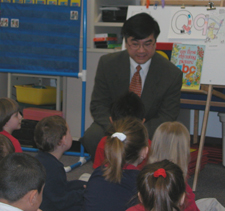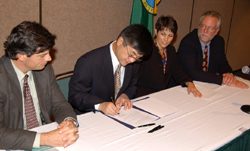
| » Return to the news room | » Working Capitol archives |
October 21, 2004
Message from the GovernorOur state faces a growing number of environmental challenges. For example, we must make sustainability part of our everyday lives, address the threat of global warming and determine what can be done about persistent bioaccumulative toxins.
As we tackle these future challenges, we must also continue to improve our own environmental regulatory system. This means continuing to streamline processes and eliminate redundancies, while still protecting our environment and maintaining our quality of life.
This is an important balance to strike, and thanks to the help and creativity of our state agency employees, we have made significant improvements in these areas in recent years. Our steady progress in regulatory reform has laid a strong foundation upon which we can build a regulatory system that already serves as a model for all states.
Environmental protection really moved to center stage in the late 1960ís and early 1970ís. But throughout the 80ís, regulations were enacted in a piecemeal fashion. These programs were established with the best of intentions to address environmental problems. But they were not done with a sense of integration or a consistent long-term vision.
As a result, we were left with a patchwork of laws and rules that were overlapping, redundant and often times counterproductive. Those laws and rules focused on specific issues and problems. There was no sense of how they fit into the bigger picture. No sense of how to make them work as a system.
In 1997, one of my first acts after taking office was to issue an executive order requiring every state cabinet-level agency to review all of its rules. I directed agencies to streamline, simplify, and clarify their rules and regulations. This was an extraordinary effort that agencies took very seriously. State agencies reviewed nearly 24,000 regulations. They repealed 6,550 administrative rules. That means we tore up more than 2,000 pages of rules and simplified thousands more into plain English.
| Quote of the Week “The challenge for government is to continue making the regulatory process more transparent and consistent. We must build in flexibility to encourage innovation, without ever lowering our standards on the environment, health, safety, and protection.” —Governor Locke, October 20, 2004 |
Over the last 8 years, we have worked to make every state agency more efficient, more effective, and their rules more understandable to the people they serve. We have had good people who have improved the systems they work in through creative thinking and their own dedication to good customer service.
All of these efforts resulted in a lot of progress in all aspects of state government, but particularly in the area of environmental regulation. Ecology has set timeliness targets for the permits it issues. It is making great progress in meeting those targets. In the 401 Water Quality Certification Program, we have significantly changed the application process so it is now more transparent, applicants get technical assistance in developing their mitigation plans, and standards are up-front. And Ecology is meeting their 90-90 goal—that is, 90 percent of 401 certifications issued within 90 days.
We have made a lot of changes. But this is only the beginning of what we can achieve in regulatory reform and environmental protection. I believe there are further actions we must take that will not only further streamline the permitting process, but also improve the way we protect the environment.
We can better utilize technology and the Internet to make services more accessible and convenient than ever before. Very soon, project directors will be able to apply for a permit over the Internet and also access detailed information on permit requirements at the federal, state and local levels. And by posting project related studies and reports online, the applicant can save time and money and the reviewing agencies will become more efficient. When we make this information available to the public earlier in the process, we can incorporate and address concerns earlier. This helps minimize appeals.
It wonít do us any good to have a simple regulatory system if we destroy our environment, endanger our children, or damage our health. As last weekís oil spill in Puget Sound demonstrated, you donít need a spill the size of the Exxon Valdez to create environmental damage, and the public deeply cares about our environment.
But to get there, we have to work together. It is the responsibility of all of us, business and government, to work together to continue to grow our economy while preserving the environmental quality of life that has attracted and kept so many companies here in our state.
Sincerely,Gary Locke
Governor
| Governor’s Priorities |
Combating Global Warming
Governor Locke called for more action in Washington state to combat global warming on October 20. The Governor has joined with Gov. Kulongoski of Oregon and Gov. Schwarzenegger of California in the West Coast Governorsí Global Warming Initiative. The three governors are currently reviewing the staff report prepared on the initiative. “Although the issue of global warming is much bigger than just the West Coast states, a regional approach will be an excellent start to addressing this problem,” the Governor said. Governor Locke called for Washington state to set greenhouse gas emissions targets, including a return to the 1990 statewide emissions level by 2010 and a target of 10 percent below 1990 levels by 2020. He also called for the state to incorporate aggressive energy efficiency measures into updates of state building energy codes and to set goals and implement strategies and incentives to increase retail energy sales from renewable resources during the next decade.
Preparing Students to Enter School
Governor Locke and Superintendent of Public Instruction Terry Bergeson unveiled the first-ever statewide guidelines for kindergarten readiness on October 19.  The Washington State Early Learning and Development Benchmarks are voluntary guidelines designed to give parents, preschool teachers and child care providers a common set of expectations of what children need to know before they enter kindergarten to ensure that they are adequately prepared for school. “We want all Washington children ready and eager to learn when they enter school,” the Governor said. “Itís vital that our kids have the proper knowledge and skills they need to succeed. If children arenít adequately prepared for kindergarten, they often fall behind and run the risk of never catching up.” After November 8, more information about the guidelines will be available at: www.governor.wa.gov/earlylearning/.
The Washington State Early Learning and Development Benchmarks are voluntary guidelines designed to give parents, preschool teachers and child care providers a common set of expectations of what children need to know before they enter kindergarten to ensure that they are adequately prepared for school. “We want all Washington children ready and eager to learn when they enter school,” the Governor said. “Itís vital that our kids have the proper knowledge and skills they need to succeed. If children arenít adequately prepared for kindergarten, they often fall behind and run the risk of never catching up.” After November 8, more information about the guidelines will be available at: www.governor.wa.gov/earlylearning/.
Reducing Smoking in Washington
Governor Locke and Mary Selecky, secretary for the Department of Health, announced on October 21 a 12 percent drop in the number of smokers in the state. This represents approximately 115,000 fewer smokers since the state began its comprehensive tobacco prevention efforts in 2000. “We have successfully reduced smoking rates in Washington, so people can live longer, healthier lives,” the Governor said. “Washington has emerged as a national leader in fighting tobacco use. Our efforts in providing secondhand smoke education, healthcare provider training, anti-tobacco and smoke-free environment campaigns have proven to be effective.” The Governor launched the stateís Tobacco Prevention and Control program in 2000 to reduce tobacco use in the state. The program currently is funded by the settlement of a lawsuit with tobacco companies, federal grants and cigarette taxes.
Creating a Sustainable State
Governor Locke directed state agencies to adopt more environmentally friendly practices and called for more aggressive actions to combat global warming on October 20.  The Governor signed an executive order directing that all new state buildings be built to green building standards. It also directs a decrease in petroleum use throughout state fleets by 20 percent in five years and orders a 10 percent reduction of energy use by state facilities, on top of the 10 percent ordered in 2001. Additionally, it requests a 30 percent reduction in paper use and an increase in purchases of paper with higher recycled content. “State government must continue to ensure that our investments in government facilities and operations provide long-term social, economic and environmental benefit,” the Governor said. ďThese actions will help both the environment and taxpayers.Ē
The Governor signed an executive order directing that all new state buildings be built to green building standards. It also directs a decrease in petroleum use throughout state fleets by 20 percent in five years and orders a 10 percent reduction of energy use by state facilities, on top of the 10 percent ordered in 2001. Additionally, it requests a 30 percent reduction in paper use and an increase in purchases of paper with higher recycled content. “State government must continue to ensure that our investments in government facilities and operations provide long-term social, economic and environmental benefit,” the Governor said. ďThese actions will help both the environment and taxpayers.Ē
Upcoming Events
10/25: Port Angeles Chamber of Commerce Luncheon
10/26: Weekly News Conference, Olympia
10/26: Foundation for Early Learning, Seattle
10/26: KCTS “Ask the Governor,” Seattle
10/28: Promise Scholarship Ceremony, Pullman
Nothing in this publication does, or is intended to, assist, promote or oppose any ballot proposition or campaign for elective office. The purpose of this publication is to improve the executive management of state government through enhanced communication of the administration's plans, objectives and accomplishments to state employees and members of the public who have requested this public information by subscribing.
| » Return to the news room | » Working Capitol archives |
Home
Governor Locke
- About the Governor
- Cabinet
- Senior Staff
- Executive Orders
- Proclamations
- Boards and Commissions
- Contact the Governor
The First Lady
News Room
About Washington
- Washington State Facts
- Photo Gallery
- The 50 State QuartersTM Program
- State Legislature
- Washington Courts
- US Census 2000
- Register to Vote